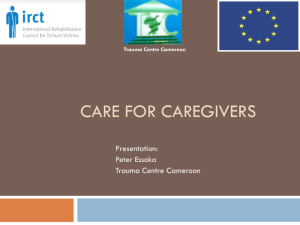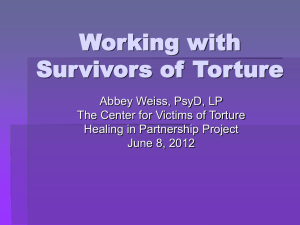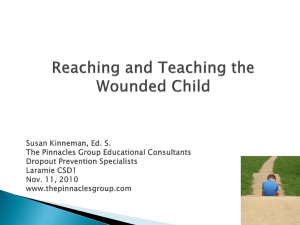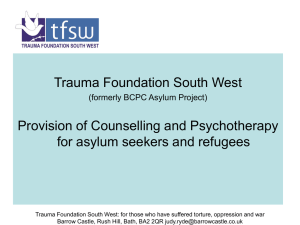Interviewing Survivors of Torture In a Legal Context: Barriers and
advertisement
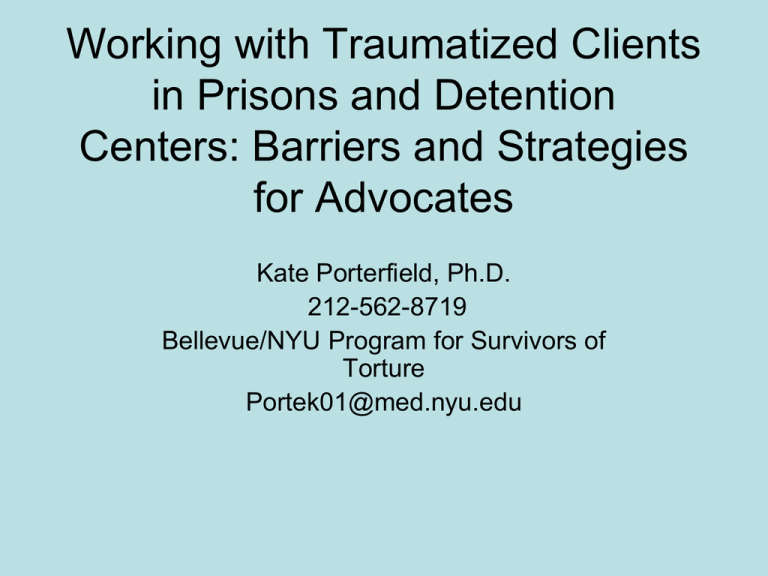
Working with Traumatized Clients in Prisons and Detention Centers: Barriers and Strategies for Advocates Kate Porterfield, Ph.D. 212-562-8719 Bellevue/NYU Program for Survivors of Torture Portek01@med.nyu.edu Goals of this session • Provide overview of effects of torture and interpersonal trauma on humans • Understand barriers that advocates face when working with a traumatized individual • Gain strategies for working with traumatized clients Cases • Case 1: 52 year old male, imprisoned since 35, with no possibility of parole. African-american, Diabetic, history of childhood abuse by father. No family contact except one daughter who writes letters sporadically. • Case 2: 30 year old Liberian male in an immigration detention center, awaiting deportation. History of imprisonment in Liberia and possible history of torture. Wife and two children are in Liberia in a refugee camp, but he has had no contact with them since leaving Liberia three years earlier. Cases, contd. • Case 3: 25 year old Pakistani female, held in pre-trial detention on charges of material support for terrorism, after assisting a family member who went to Pakistan for alleged terrorist activities. Has been unwilling to speak to lawyers. • Case 4: 35 year-old male, held on death row, awaiting appeals. White, convicted of murder in the context of hate crime, member of a white supremacy group in jail. History of childhood abuse, question of mental retardation. What is trauma and what does it do to us? • Event outside normal range of experiences (life-threatening, threat to bodily integrity) that results in… • Experience of terror, horror. • “Man-made” trauma (torture, abuse, war) vs. Natural disasters What is Torture?* • Severe pain or suffering (physical or mental) • Intentionally inflicted • For a purpose: eg. to obtain information or confession; as punishment for a suspected act; or for purposes of humiliation, intimidation and coercion • Inflicted by or at the acquiescence of public officials *UN Convention against torture and other cruel, inhuman or degrading treatment or punishment Occurrence of Torture Studies show torture among refugee populations varies from 5% to 35%. (Baker, 1992; Jacobsen & Vesti, 1990 ) Torture and ill-treatment are widespread in 111 countries worldwide. (Amnesty International Report , 2009) It is estimated that 400,000 Survivors of Torture live in the U.S. (Center for Victims of Torture, report to the DJJ Office of Victims of Crime, 1998) Sitting with a severely traumatized client • Must understand that the traumatic history is in the room and playing a part in the client’s perceptions/interactions with you • The more you understand the effects of long-term trauma, the more you can recognize and address barriers that exist in your interaction TRAUMA: UNDERSTAND THE PHENOMENA BEFORE THE DIAGNOSIS Post Traumatic Stress Disorder Depression TERROR LOSS/ POWERLESSNESS PTSD – A disorder of memory and arousal • Amygdala and hippocampusinvolved in: 1. registering danger (“fight or flight”) and 2. formation of memories • Fear Network (cognitive, sensory, physiological, emotional experiences) is established with “faulty” connections –arousal linked to memory Perceptions are stored in highly aroused stateFEAR NETWORK Network is reactivated by triggers— EXTREME DISCOMFORT Individual expends great energy avoiding reminders Posttraumatic Stress Disorder (PTSD) • • • Reexperiencing: intrusive thoughts and images, flashbacks, nightmares Hyperarousal: poor sleep, irritability, startle response, poor concentration Avoidance: numbing, emotional constriction, avoiding reminders of the trauma QuickTime™ and a decompressor are needed to see this picture. Complex Trauma • Often seen in those with early and chronic trauma; Can come out of extensive adult trauma • In 2006, almost 500,000 substantiated cases of abuse/neglect of a child under 7, 83% were abused by parent or primary caretaker • Almost half were reported abused or neglected again within 5 years • (American Academy of Experts in Traumatic Stress: www.aaets.org/article174.htm) Complex Trauma impacts multiple aspects of a human’s functioning--i.e. the whole system • Alterations in: – Regulation of affect and impulses – Attention or consciousness – Self-perception – Relations to others – Body functioning and integrity (somatization) – Systems of meaning (Roth et al., (1997-full citation at end) What does it feel like to be with someone with Complex PTSD? And what can you do to do good, effective work? General Principles • Recounting the events of abuse is extremely stressful and potentially retraumatizing for the victim. • Listening to accounts of torture/trauma can be very stressful for the interviewer as well. (Vicarious traumatization.) • Establishing a rapport and eliciting a thorough and complete history takes time. General Principles (cont.’d) • There is variability in: – the degree of physical and psychological signs, symptoms or consequences which a torture victim will manifest. – the manner in which trauma/torture victims conduct themselves in interviews and in recounting the events of their abuse. – the amount and detail of information which an individual will recall with regards to the events of the trauma. When working with a traumatized individual • Anticipate barriers • Create strategies for addressing those barriers • Set realistic goals for yourself and for the client • Be aware of and attentive to your own reactions Potential Barriers to Effective Communication • Environmental barriers • Lack of privacy or a comfortable setting • Inadequate time • Reminders in the room • Physical Barriers • Pain, fatigue, sensory deficits • Sociocultural Barriers • Gender issues, interpreters, reaction to authority, Psychological barriers to communication for a traumatized person • Disruptions in memory, concentration and cognitive abilities • Impairment in reality testing • Interpersonal discomfort/distortion • Avoidance of conversations about trauma • Detachment from emotional responses • Increased anxiety when remembering • Narrative inconsistencies • Shame when recounting Communication Strategies • Help client anticipate: Lay out the time frame/structure of the interview; tasks, goals, and why you are asking about what you are asking about • Allow time to build rapport, trust • Talk about talking • Invite questions • Normalize reactions: “Many people feel…” • Provide closure: Discuss experience of interview at the end and anticipate the next step if possible Types of client “problems” The withdrawn client • Strategy: Try to gently engage by normalizing and providing a feeling of control: “Sometimes people have a hard time answering these questions. I know that you have been asked a lot of questions and that you are probably concerned about answering any more. Is there something that you would like me to know before I ask you some of my more specific questions?” Strategy: Return to education about why you are asking detailed questions about particular issues: • “We really need to convey to the court what you have been through and how much you have suffered. Often times these are the most difficult things to discuss, but they can be the most important things for the Court to understand in order to know the truth about how you were treated.” Strategy: Return to the reason for the question and how it can be helpful to the client: • “One thing that is difficult about our legal system is its adversarial nature, which means that it is the job of the lawyer on the other side to try to argue with or challenge your story. This means that we have to anticipate these challenges and address them ourselves so that we are prepared.” The “flooding” client • What is flooding? --An overload of information/expression --Content/facts --Emotions --Often feels hard to stop or contain Strategy: Try to contain, both by providing more structure in the interview, suggesting short breaks, and explaining why you need to focus on certain issues • “I can understand how important it is for you to make sure I understand what you are telling me. I want to hear the things that are important to you. I also have some specific things I want to hear about today, so I’d like to make time to talk about those things.” Strategy: End the interview if necessary: – Client is unable to contain emotions at all – Client is incoherent, even after attempts to ask more basic questions – Client becomes aggressive, overtly hostile The hopeless client • Strategy: Reflect back what you see and empathize “I can see that you don’t believe it’s worth it to try to do anything to fight for your case. I know that I am not in your position and can’t imagine how you feel. But I really understand that you are telling me you cannot fight this situation anymore.” Strategy: Share your commitment • “Even though I hear what you are saying about not wanting to fight anymore, I want to explain my position and my beliefs. I believe that you and your case are worth fighting for. I’d like to tell you why…” Strategy: Make small work commitments together • “I know you are saying you don’t want to keep up this fight forever. How about if we agree to keep working for the next month and see how you feel after that?” HUMANIZE • THE SINGLE MOST EFFECTIVE “STRATEGY” WITH A TRAUMATIZED PERSON • How? – Genuineness – REAL Listening – Self-disclosure (CAREFULLY) – Transparent expressions of desire to understand and assist Other interview challenges • Delivering bad news – Be direct – Do not try to “spin it” right away – Share your reaction if appropriate but it is not about “you” – Ask for reaction/Reflect back what you hear – Recognize that it takes time to deal with bad news • Ending your work with a client – Use above principles – Do not avoid – Be genuine Self-care for the evaluator Vicarious traumatization • Can occur in those who work with survivors of severe trauma • Can be a normal reaction to hearing very vivid, distressing narratives. • Manifests itself in distress and symptoms of PTSD (e.g., nightmares, irritability, anger). • Feelings of demoralization and depression are also frequent. • Can feel like you are a victim/perpetrator Strategy: managing boundaries • Clarifying the limits of your role with your clients • Clarifying what you CAN do for your client • Tolerating feelings of guilt and helplessness • Recognizing fantasies of rescue and omnipotence Strategy: Attending to and processing team dynamics • • Recognizing team members’ different ways of coping with the stress (e.g.-the staff member who “gives extra”, the staff member who withdraws, the staff member who rants). Building time for team to process experiences together. Sources • Robins, et. al., (2005) Psychiatric problems of detainees under the Anti-Terrorism Crime and Security Act 2001, The Psychiatrist (2005) 29: 407-409. • Cook, A., Blaustein, M., Spinazolla, J., van der Kolk, B. (2003). Complex trauma in children and adolescents. White paper from the national child traumatic stress network complex trauma task force. Los Angeles, CA: National Center for Child Traumatic Stress • Cook, A., Spinazzola, J., Ford, J., Lanktree, C., et al. (2005). Complex trauma in children and adolescents. Psychiatric Annals, 35:5, 390-398. • Roth, S., Newman, E., Pelcovitz, D., van der Kolk, B., & Mandel, F.S. (1997). Complex PTSD in victims exposed to sexual and physical abuse: Results from the DSM-IV Field Trial for Posttraumatic Stress Disorder. Journal of Traumatic Stress 10, 539556. Sources (contd.) • “Leave No Marks: Enhanced InterrogationTechniques and the Risk of Criminality.” Physicians for Human Rights/Human Rights First. Available at: www.phrusa.org • Scott Allen, M.D. Center for Prisoner Health and Human Rights, The Warren Alpert Medical School, Brown University Extra slides follow on Complex Trauma Complex Trauma impacts multiple aspects of a child’s functioning--i.e. the whole system • Attachment-boundary problems, mistrust, isolation, difficulty attuning to others or enlisting others as allies • Biology-sensorimotor problems, coordination/balance problems, somatization • Emotional regulation- high intensity emotions, pervasive negative feelings, emptiness, oscillation between over-expression and overinhibition of emotions (American Academy of Experts in Traumatic Stress: www.aaets.org/article174.htm) Complex Trauma impacts multiple aspects of a child’s functioning--i.e. the whole system (contd) • Dissociation-alterations in consciousness, amnesia, multiple states of consciousness • Behavior/Impulse control- poor control; self-destructive behavior, aggression, sleep/eating disturbance, substance abuse; difficulty with rules; repetition • Cognition- attention, concentration, executive functioning/planning, impairment in language, visuospatial, acoustic processing • Self-Concept- fragmented sense of self, poor selfesteem, shame/guilt, poor sense of separateness, body image





